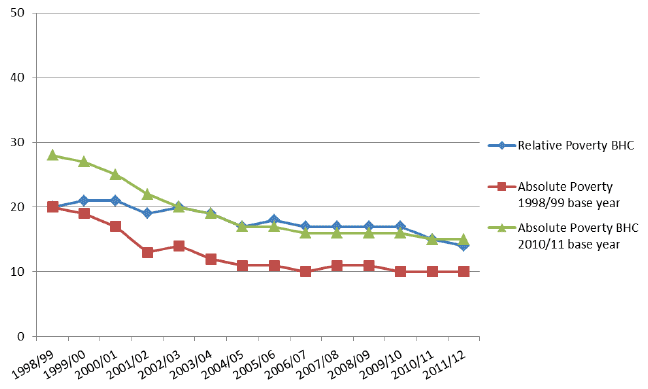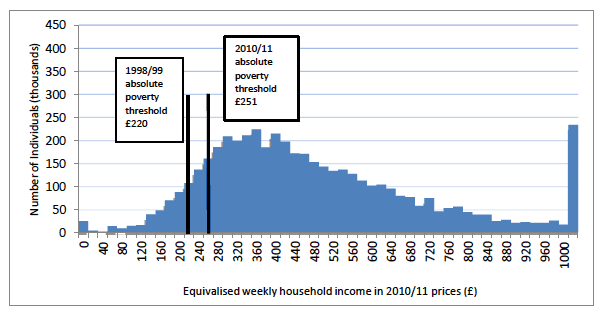Poverty and Income Inequality in Scotland 2011/12
Statistics on the percentage and number of children, working age adults and pensioners living in low income households in Scotland, and the distribution of household income across Scotland.
This document is part of a collection
Annex 3: Impact of change to reference year for absolute poverty
For the 2005/06 to 2010/11 publications, absolute poverty was measured against 60% of median household income in 1998/99 adjusted for inflation. In order to keep the absolute low income measure in line with the Child Poverty Act 2010, the reference year for measuring absolute low income has been changed to 2010/11, adjusted for inflation from 2011/12.
The change in the reference year has a large effect on the percentage and number of people identified as being in absolute poverty. It also magnifies the scale of historical changes in the time series. This is because the threshold has moved to a more densely populated part of the income distribution. The change in the headline figure does not reflect a real change in the living standards of those who now fall below the rebased poverty line, nor does it reflect a worsening economic situation than previously published. It is a re-classification of 'absolute poverty'.
Chart A11 below shows the percentage of the population in Scotland identified as being in absolute poverty (BHC) using both the 1998/99 and 2010/11 base years. This clearly shows the increase in the population identified as being in absolute poverty using the 2010/11 base year.
Chart A11: Comparison of absolute poverty with 1998/99 base year, absolute poverty with 2010/11 base year and relative poverty, Before Housing Costs.

The change in the base year means the absolute poverty threshold has moved from £231 per week (1998/99 base year) to £264 per week (2010/11 base year) in 2011/12 prices. When this shift is shown in the context of the income distribution, the threshold has moved into a denser part of the income distribution. This means that not only is more of the population identified as in absolute poverty but also historical changes are larger.
The following chart and commentary explain the difference between the 1998/99 base year and the 2010/11 base year. As such they use 2010/11 prices and so values for median income and poverty thresholds are not the same as those presented elsewhere in this bulletin (2011/12 prices)
Chart A12: Income distribution for the total population, 2010/11, with 1998/99 and 2010/11 absolute low income thresholds.

This increase in threshold has meant a larger scale of change is seen between years. For example, using the 1998/99 baseline series the 60% absolute poverty threshold moved from £209 per week in 2009/10 to £220 per week in 2010/11. This change compared to the income distribution in 2010/11 meant that 10% of the population in Scotland were in absolute poverty in 2010/11 (unchanged from 2009/10). Using the 2010/11 baseline series, the absolute poverty threshold moves from £239 per week in 2009/19 to £251 per week in 2010/11. Although the monetary change is similar, the threshold is now in a denser part of the income distribution, with 15% of the population classified as being in absolute poverty (compared with 16% in 2009/10). The effect is a product of moving the absolute poverty measure to a new baseline and does not reflect a worsening in household living standards or a worsening economic situation than previously estimated.
A similar effect is seen on the estimated number of individuals in absolute poverty. Using the 1998/99 baseline series, 490 thousand individuals were in absolute poverty in 2010/11 (a decrease of 20 thousand compared with 2009/10). Using the 2010/11 baseline series 780 thousand individuals were in absolute poverty in 2010/11 (a decrease of 10 thousand on the previous year). Note that population estimates are rounded to the nearest 10 thousand. The change in absolute poverty between 2009/10 and 2010/11 using 1998/99 baseline and the 2010/11 baseline is not statistically significant.
Contact
Email: Stephen Smith
There is a problem
Thanks for your feedback